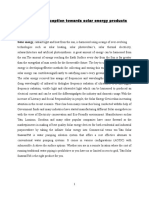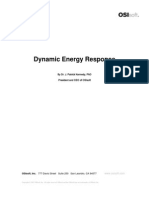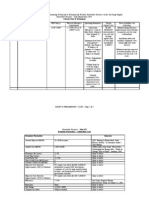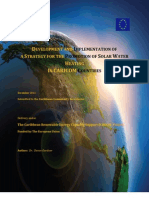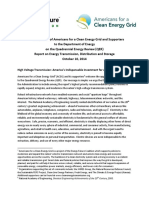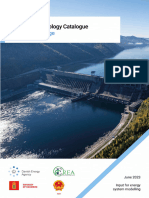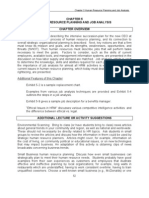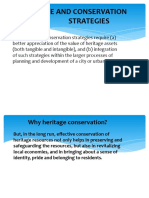0-7803-7322-7/02/$17.00 (C) 2002 Ieee
0-7803-7322-7/02/$17.00 (C) 2002 Ieee
Uploaded by
Armaghan JamshaidCopyright:
Available Formats
0-7803-7322-7/02/$17.00 (C) 2002 Ieee
0-7803-7322-7/02/$17.00 (C) 2002 Ieee
Uploaded by
Armaghan JamshaidOriginal Title
Copyright
Available Formats
Share this document
Did you find this document useful?
Is this content inappropriate?
Copyright:
Available Formats
0-7803-7322-7/02/$17.00 (C) 2002 Ieee
0-7803-7322-7/02/$17.00 (C) 2002 Ieee
Uploaded by
Armaghan JamshaidCopyright:
Available Formats
2.
UNTAPPED POTENTIAL, Richard Spencer, World Bank
YES: BUT WHAT WILL TURN THE SPIGOT?
General remarks: Technology costs have come down hugely and wind is now knocking at the door of coal, nuclear and even gas as the least-cost energy source in developed countries. From his experience in the UK he is aware of wind farms that have put in bids under NFFO at about 3 US cents/kWh and he imagines this is a benchmark for many projects in the US. Yet in many of the World Banks client countries, which have good and in some cases outstanding wind regimes, costs are much higher, installed capacity is low, and the prospects gloomy. In his analysis, he will use illustrations from those countries in which he has, or is working on wind energy investment projects with their clients. These are principally in Cape Verde, China, Egypt, and Morocco. 2.1 Sector Structure
Electricity is a sector which is still emerging from dominance with most of their clients in state-owned monopoly utilities, where generation, transmission and distribution is bundled together. Many electricity sectors are undergoing reform and restructuring but progress is uneven. Some countries are further down the path of reform than others. There are few, if any truly open electricity markets where a generator can set up shop to sell electricity. Often utilities resist moves to include renewables in their generation mix: immaturity of the technology, small size of the projects, and fears for system stability are the most frequently cited reasons. At best, generators may have the option to respond to set-piece requests for proposals to supply electricity either under EPC or BOO/BOOT/BOT arrangements that are published by electricity utility or government authorities. Quite often it is difficult to separate one from the other, given closeness of the policy, and the regulatory and operational framework in many countries. Some of the bids have resulted in strong competition and quite low prices; but (i) they do not represent a proper market since they are called at a time, frequency, site, and size of the utilitys choosing and (ii) they are not sustainable over the long term because BOO/BOOT/BOT arrangements are not compatible with the development of wholesale electricity markets. 2.2 Financial vs. Economic Valuations
An economic analysis often reveals that wind-power is competitive with conventional power. But such an analysis strips out distortions such as input fuel subsidies, taxes, and cross subsidies between different classes of consumer and uses the opportunity cost of capital as the discount rate; it also includes valuations for environmental externalities associated with burning fossil fuels. On the other hand, a real world project, which has to obtain financing, does not and has to compete with those distortions. Moreover, financing availability and conditions for wind projects, especially when they are new in the market, are often more stringent than for conventional power. Thus what often seems economically attractive can be financially difficult to put into practice.
0-7803-7322-7/02/$17.00 (C) 2002 IEEE
342
2.3
The Wind Industry
Has Not Always Helped Itself
The wind industry has been quick to identify those countries where there is a good wind regime and what they see as a good market opportunity. Many of these opportunities are in countries, that receive official development assistance. The industry has been able to persuade their own governments to support demonstration wind farms under aid budgets. While this can be useful if technical demonstrations are required, it does little to stimulate development of a market and the entire market infrastructure that is needed to make it competitive. This is not just the ability to manufacture equipment locally - starting with towers and working up. It includes all the software that is needed to do good wind projects - knowledgeable and experienced consultants, engineers, financiers, sub contractors, ancillary equipment suppliers, service staff and so on. Unless one builds these up in the country or at least regionally, the demonstration projects lead nowhere. Another follows normally one demonstration - with all the bilateral donors competing with one another. In China, nearly all the 360 MW installed wind capacity is bilaterally funded projects. 2.4 So What Is the Answer?
The primary concern should be to build sustainable long term markets, in which wind can compete on a level playing field, with the private sector undertaking most, if not all the construction, financing, operation and maintenance of Wind Farms with their output being sold into the wholesale electricity market. That is what the Bank is increasingly focusing on- a long way from old-fashioned lending for big lumps of infrastructure. They do this by working on policy and regulatory issues relating to renewables. Of particular recent importance are the introducjion of mandated market schemes (Renwables Portfolio Standards, Systems Benefit Charge and Feed-in Tariffs) accompanied market development measures to help support the growth of the market infrastructure.
Richard Spencer is a senior energy specialist with the Energy and Water Department of the World Bank. He is working on a variety of lending and technical assistance projects, mainly in the Middle East and North Africa and China. Since joining the Bank, he has spent most of his time working on energy efficiency and renewable energy projects and the Bank is now probably the largest financier of renewable energy in the developing world. Jointly with the Environment Department, he produced the Banks recent strategy Fuel for Thought: An Environmental Strategyfor the Energy Sector. Before taking up his position in the Bank, he was a manager at the UKs Energy Technology Support Unit, responsible for the UK governments renewable energy R&D and deployment program. Biography Pending
343
You might also like
- Bankability of RE Project, A PaperDocument19 pagesBankability of RE Project, A PaperJinlong MaNo ratings yet
- C 4: P F P C: Hapter Olicy Ramework For Romoting OgenerationDocument10 pagesC 4: P F P C: Hapter Olicy Ramework For Romoting OgenerationbarmarwanNo ratings yet
- The Clean GenerationDocument6 pagesThe Clean GenerationdianambzNo ratings yet
- Nuclear Power PlantDocument11 pagesNuclear Power Plantshefali08072007No ratings yet
- How To Finance A Nuclear Programme?: Roundtable - Monday 8 March - 2:00Document6 pagesHow To Finance A Nuclear Programme?: Roundtable - Monday 8 March - 2:00ahmednppNo ratings yet
- PHD Thesis Renewable Energy EconomicsDocument4 pagesPHD Thesis Renewable Energy EconomicsAndrew Molina100% (2)
- 2013-11-06 - ARE Position Paper - Public Procurement - Lessons Learned - ...Document3 pages2013-11-06 - ARE Position Paper - Public Procurement - Lessons Learned - ...Detlef LoyNo ratings yet
- DRAFT - NIAC - Addressing The Critical Shortage of Power Transformers To Ensure Reliability of The U.S. Grid - ReportDocument27 pagesDRAFT - NIAC - Addressing The Critical Shortage of Power Transformers To Ensure Reliability of The U.S. Grid - Reportjaehi wooNo ratings yet
- BP Energy Wind EnergyDocument54 pagesBP Energy Wind EnergyEng Bile LastroNo ratings yet
- DOEQERITIcomments2014_0Document12 pagesDOEQERITIcomments2014_0laemoh712No ratings yet
- Economic Analysis of The Multi-Tenant Residential Retrofit Market: A Perspective On ESCOs (2009)Document19 pagesEconomic Analysis of The Multi-Tenant Residential Retrofit Market: A Perspective On ESCOs (2009)Jake Henry WiseNo ratings yet
- The Challenges of Transmission Expansion in The Chilean Power Sector: Market or Central Planning?Document13 pagesThe Challenges of Transmission Expansion in The Chilean Power Sector: Market or Central Planning?Oscar Cabrera ChirreNo ratings yet
- ESN Elec Storage in The National Interest Report Final Web PDFDocument8 pagesESN Elec Storage in The National Interest Report Final Web PDFroyclhorNo ratings yet
- NEM DG Guidelines Final 7-12-01Document17 pagesNEM DG Guidelines Final 7-12-01api-3697505No ratings yet
- Solar Energy Products ADocument29 pagesSolar Energy Products AAmit GusainNo ratings yet
- The Economics of Renewable EnergyDocument10 pagesThe Economics of Renewable EnergyThe Royal Society of EdinburghNo ratings yet
- Remake With All DetailsDocument5 pagesRemake With All Detailssse.nagpur1No ratings yet
- Renewable Energy Financing Issues in Developing Countries For ReviewDocument89 pagesRenewable Energy Financing Issues in Developing Countries For ReviewAtipo Ambrose Peter D100% (1)
- BoozCo Renewable Energy Technologies CrossroadsDocument24 pagesBoozCo Renewable Energy Technologies CrossroadsSikander GirgoukarNo ratings yet
- Writting Sample - Case Study - Electric HydrogenDocument9 pagesWritting Sample - Case Study - Electric Hydrogenjacobalmanzar.98No ratings yet
- Lecture 6 Project Green Bonds. How Green Is Your AssetDocument26 pagesLecture 6 Project Green Bonds. How Green Is Your AssetLouis LagierNo ratings yet
- PV 5Document23 pagesPV 52guntanNo ratings yet
- Abstracts For The Journal of Energy and Development Volume 40, Number 2, Spring 2015Document5 pagesAbstracts For The Journal of Energy and Development Volume 40, Number 2, Spring 2015The International Research Center for Energy and Economic Development (ICEED)No ratings yet
- Afv Fueling Infrastructure Deployment Barriers PDFDocument33 pagesAfv Fueling Infrastructure Deployment Barriers PDFMuhammad Imran KhanNo ratings yet
- PUF 04012010 - BeyondGreenHype - JES8Q1Document5 pagesPUF 04012010 - BeyondGreenHype - JES8Q1eeftingmNo ratings yet
- Risks of A Hydro Power ProjectDocument20 pagesRisks of A Hydro Power ProjectZafarNo ratings yet
- CCJ2016Q3-50 - Is The Plant Worth The PriceDocument2 pagesCCJ2016Q3-50 - Is The Plant Worth The PricenickchoNo ratings yet
- The Impact of Financial Structure On The Cost of Solar EnergyDocument40 pagesThe Impact of Financial Structure On The Cost of Solar EnergyAlexander Vova100% (1)
- Smart Grid Conference 05 13 2009Document12 pagesSmart Grid Conference 05 13 2009Irodov IlizarovNo ratings yet
- Make A Power Point Presentation On Economics of R... - 1Document4 pagesMake A Power Point Presentation On Economics of R... - 1sse.nagpur1No ratings yet
- Solar ProjectDocument7 pagesSolar ProjectPriyanka MishraNo ratings yet
- Dynamic Energy Response WPDocument12 pagesDynamic Energy Response WPwidayat81No ratings yet
- 06 Libya PSP in RE Report FinalDocument233 pages06 Libya PSP in RE Report FinalCésar AndrésNo ratings yet
- Master Thesis On Renewable EnergyDocument10 pagesMaster Thesis On Renewable Energyafcnczadf100% (2)
- Transformation of The American Electric Grid: The Unmet Agenda (D. Victor, D. Fedor, R. Buechler)Document24 pagesTransformation of The American Electric Grid: The Unmet Agenda (D. Victor, D. Fedor, R. Buechler)Hoover Institution100% (2)
- Solar Parameter SummaryDocument5 pagesSolar Parameter Summarysrivastava_yugankNo ratings yet
- Make A Power Point Presentation On Economics of R...Document5 pagesMake A Power Point Presentation On Economics of R...sse.nagpur1No ratings yet
- The Zero Subsidy Renewables OpportunityDocument44 pagesThe Zero Subsidy Renewables OpportunityTNo ratings yet
- Nuclear Lessons Learned PDFDocument80 pagesNuclear Lessons Learned PDFhuangjlNo ratings yet
- Devon Gardner, Development and Implementation of A Strategy For The Promotion of Solar Water Heating in CARICOM Countries, Dec. 2011Document251 pagesDevon Gardner, Development and Implementation of A Strategy For The Promotion of Solar Water Heating in CARICOM Countries, Dec. 2011Detlef LoyNo ratings yet
- Electrification Africa The Challenge: BackgroundDocument5 pagesElectrification Africa The Challenge: BackgroundDetlef LoyNo ratings yet
- Project Finance For Offshore Wind A Practitioner's View: EWEC 2010Document9 pagesProject Finance For Offshore Wind A Practitioner's View: EWEC 2010Joseph FrereNo ratings yet
- Financing US Renewable Energy Projects Through Public Capital Vehicles - WWWDocument38 pagesFinancing US Renewable Energy Projects Through Public Capital Vehicles - WWWDrew SmithNo ratings yet
- RE Technologies Cost Analysis-BIOMASS PDFDocument60 pagesRE Technologies Cost Analysis-BIOMASS PDFHeri SetyantoNo ratings yet
- An Overview of Recent Events For Renewable Energy in Timor-Leste (As of 03 March 2010)Document4 pagesAn Overview of Recent Events For Renewable Energy in Timor-Leste (As of 03 March 2010)scttmcknnnNo ratings yet
- PWC Offshore WindDocument20 pagesPWC Offshore WindChubakabarabakaNo ratings yet
- 44MOXO9ZDH10QSEVQDD1J3KGYN7IF7Document4 pages44MOXO9ZDH10QSEVQDD1J3KGYN7IF7gosaye desalegnNo ratings yet
- EVS Vanshika AnandDocument8 pagesEVS Vanshika Anandvanshika anandNo ratings yet
- Assignment in Electrical Standards and PracticesDocument4 pagesAssignment in Electrical Standards and PracticesJade Danielle Enmoceno FortezaNo ratings yet
- Supplemental Comments: The New York Energy Consumers Council Inc.'s Supplemental Comments To Notice Soliciting Comments, Issued January 9, 2023Document6 pagesSupplemental Comments: The New York Energy Consumers Council Inc.'s Supplemental Comments To Notice Soliciting Comments, Issued January 9, 2023rociodelcisne16usaNo ratings yet
- Americans For Clean Energy Grid Comments 2014Document16 pagesAmericans For Clean Energy Grid Comments 2014Jose GasconNo ratings yet
- Financial Analysis of Household Photovoltaic Self-Consumption in The Context of The Vehicle-to-Home (V2H) in PortugalDocument21 pagesFinancial Analysis of Household Photovoltaic Self-Consumption in The Context of The Vehicle-to-Home (V2H) in PortugalJoel VazNo ratings yet
- Business Plan For EV ReadDocument31 pagesBusiness Plan For EV ReadAaron HtetAungLinnNo ratings yet
- Module 1 Introduction, Energy. 17006296558330Document53 pagesModule 1 Introduction, Energy. 17006296558330mahatosuraj078No ratings yet
- TET 407 - Energy Planning, Regulation & Investment PlanningDocument69 pagesTET 407 - Energy Planning, Regulation & Investment PlanningMonterez SalvanoNo ratings yet
- Viet Nam Technology Catalogue draft 2023 - Storage_for hearing_FinalDocument71 pagesViet Nam Technology Catalogue draft 2023 - Storage_for hearing_Finaltuan vaNo ratings yet
- Wind Project Financing StructuresDocument82 pagesWind Project Financing StructuresSajjad JafferNo ratings yet
- Investing in the Renewable Power Market: How to Profit from Energy TransformationFrom EverandInvesting in the Renewable Power Market: How to Profit from Energy TransformationNo ratings yet
- Reading 72 Introduction To The Global Investment Performance Standards (GIPS)Document5 pagesReading 72 Introduction To The Global Investment Performance Standards (GIPS)Vân TrườngNo ratings yet
- Advanced Financial Accounting Assignment: QuestionDocument2 pagesAdvanced Financial Accounting Assignment: QuestionAyyan AzeemNo ratings yet
- Assignment: Submitted By:-Rishabh Shukla 0191PGM127Document2 pagesAssignment: Submitted By:-Rishabh Shukla 0191PGM127rishabhNo ratings yet
- Faheem Shaikh: Business Head at Redecom PakistanDocument2 pagesFaheem Shaikh: Business Head at Redecom PakistanFaheem ShaikhNo ratings yet
- The Mobile Economy Global 2018 PDFDocument60 pagesThe Mobile Economy Global 2018 PDFSanchit TanejaNo ratings yet
- Traveleasy LTD Management Accounts Profit and Loss StatementDocument5 pagesTraveleasy LTD Management Accounts Profit and Loss StatementSitakanta AcharyaNo ratings yet
- New Era For The Philippines - Membership in The BEPS Inclusive FrameworkDocument6 pagesNew Era For The Philippines - Membership in The BEPS Inclusive FrameworkEllis Louise LansanganNo ratings yet
- Overview Presentation On e-GPDocument13 pagesOverview Presentation On e-GPblessing aasisNo ratings yet
- ANSWERS - MODULE 5 For TeamsDocument4 pagesANSWERS - MODULE 5 For Teamsbhettyna noayNo ratings yet
- Kano's Tricycle Income Statement August 31, 2019Document8 pagesKano's Tricycle Income Statement August 31, 2019Mae QuidadoNo ratings yet
- Sources of Vietnam's Economic Growth: Phan Minh Ngoc, DRDocument50 pagesSources of Vietnam's Economic Growth: Phan Minh Ngoc, DRGiang HoangNo ratings yet
- Derivatives TYFM Unit 1Document64 pagesDerivatives TYFM Unit 1sacos16074No ratings yet
- Cost of Poor Quality - WorkshopDocument22 pagesCost of Poor Quality - WorkshopNivedita SahooNo ratings yet
- CH 05Document11 pagesCH 05Samsul ArifinNo ratings yet
- Early Gurus of TQM: Joseph M. Juran's Ten Steps To Quality Improvement WereDocument5 pagesEarly Gurus of TQM: Joseph M. Juran's Ten Steps To Quality Improvement WereHaider BukhariNo ratings yet
- Employability Skills - Entrepreneurship Skills Model QuestionsDocument1 pageEmployability Skills - Entrepreneurship Skills Model QuestionsSAVITA MAURYANo ratings yet
- WalmartDocument2 pagesWalmartKaranam reechaNo ratings yet
- Heritage and Conservation Pp.Document11 pagesHeritage and Conservation Pp.Jayson Kerth SeveroNo ratings yet
- Imperial AgencyDocument2 pagesImperial AgencySwift DataNo ratings yet
- Collateralised Borrowing and Lending ObligationDocument2 pagesCollateralised Borrowing and Lending ObligationSamhitha Kandlakunta100% (1)
- Top Business Environment McqsDocument4 pagesTop Business Environment McqsSatyam SinghNo ratings yet
- Antares Binari Profit Program Explanations - Antares Trade in Binary System - Investment Opportunity in March 2020Document13 pagesAntares Binari Profit Program Explanations - Antares Trade in Binary System - Investment Opportunity in March 2020Khairun NafisNo ratings yet
- Krishnan Ramanathan InternshipDocument14 pagesKrishnan Ramanathan InternshipAsish KumarNo ratings yet
- Entrepreneurship by Robert D Hisrich, Entrepreneurship by Robert D Hisrich, Michael P Peters, Dean A Shepherd Michael P Peters, Dean A ShepherdDocument40 pagesEntrepreneurship by Robert D Hisrich, Entrepreneurship by Robert D Hisrich, Michael P Peters, Dean A Shepherd Michael P Peters, Dean A ShepherdSubheesh S Anand100% (1)
- Pre-Feasibility Desk Study Lamu Port Offshore Energy Industrial ParkDocument11 pagesPre-Feasibility Desk Study Lamu Port Offshore Energy Industrial ParkEric Mwangi NjorogeNo ratings yet
- How Do Big European Companies Present Themselves To Attract The Most Talented PeopleDocument65 pagesHow Do Big European Companies Present Themselves To Attract The Most Talented PeoplePallavi PandeyNo ratings yet
- Ikea 2Document4 pagesIkea 2My PhamNo ratings yet
- 5 Traffic ForecastsDocument3 pages5 Traffic ForecastsMitzOsorioNo ratings yet
- Fin081 Liquidity Ratio Au Fa1 Bsa2 Main6Document11 pagesFin081 Liquidity Ratio Au Fa1 Bsa2 Main6Mariel DichosoNo ratings yet
- Marketing Project Report On Haldiram SDocument64 pagesMarketing Project Report On Haldiram SDhruv Dang100% (1)















